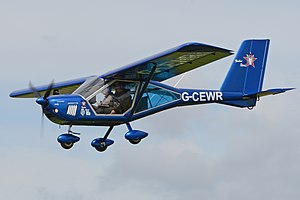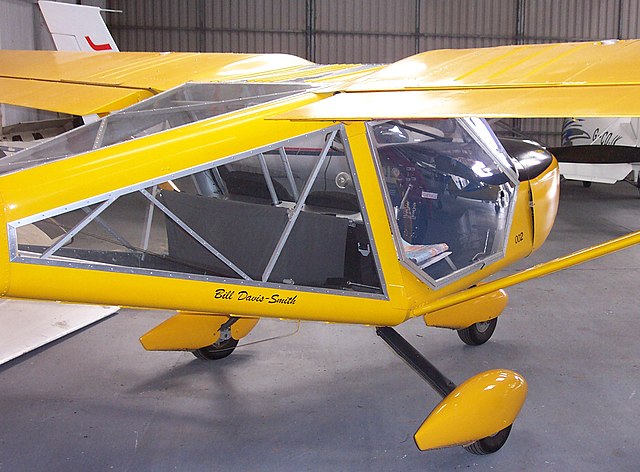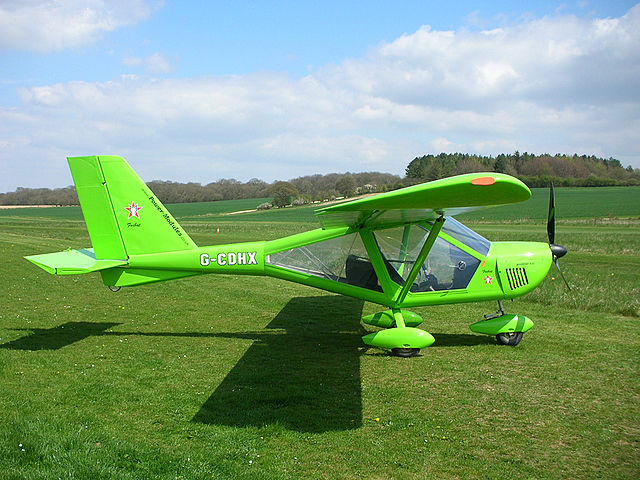Aeroprakt A-22 Foxbat
Type of aircraft From Wikipedia, the free encyclopedia
The Aeroprakt A-22 Foxbat is a Ukrainian two-seat, high-wing, tricycle landing gear ultralight aircraft that was designed by Yuri Yakovlev and is manufactured by Aeroprakt. In the United States the A-22 is referred to as the Valor,[2] while in the UK and Australia it is called the Foxbat. It has also been marketed as the Vision.[3][4][5] The Aeroprakt A-22 is supplied either as "ready-to-fly" factory built aircraft, or as a kit,[3] consisting of 152 pieces. The kit can be built in about 500 man-hours.
| A-22 Foxbat | |
|---|---|
 | |
| Role | Sports Light Aircraft |
| National origin | Ukraine |
| Manufacturer | Aeroprakt |
| Designer | Yuri Yakovlev |
| First flight | 21 October 1996 |
| Introduction | 1999 |
| Status | In production |
| Produced | 2000-present |
| Number built | 1,600[1] |
| Variants | Aeroprakt A-32 Vixxen |




The A-22 meets the definition of an FAI microlight.[3][4]
According to Yakovlev, around 1,600 were built as of April 2024. Of these, 100 were sold to Russia before the start of the Russo-Ukrainian War.[1]
History
Summarize
Perspective
Design and development
Aeroprakt of Kyiv began design of the A-22 in February 1990, with the first prototype making its maiden flight on 21 October 1996, and a German-certified version entering production in 1999.[6]
The A-22's structure is almost completely metal with the engine cowling, wing fillets and wheel spats made of composites. The wings and control surfaces are fabric covered. The aircraft has excellent visibility, due to the large amount of glazing, including convex doors, that allow the occupants to look straight down. The A-22 uses a 3-axis control system, giving the pilot full control over the aircraft. The A-22 uses flaperons in place of ailerons and flaps, giving a stall speed of 52 km/h (32 mph) with the flaperons fully down.[3][7]
The kit comes with either the 80 hp (60 kW) Rotax 912UL or optionally the 100 hp (75 kW) Rotax 912ULS. The 85 hp (63 kW) Jabiru 2200 can also be fitted.[3][4]
Originally the A-22 came fitted with a 40-litre inboard fuel tank behind the seats, although later models have wing tanks holding 37.5 litres per side. The propeller is a 3-blade composite ground adjustable KievProp. Dual controls are standard, using a single central "Y" yoke or optionally twin yoke control system.
Military usage
Faced with a lack of long-range precision weapon systems and restrictions on the use of Western-supplied cruise missiles, Ukraine began developing loitering munitions to strike strategic targets located deep inside Russian territory. Initially the Ukrainian Armed Forces made use of converted fixed-wing aircraft procured from the civilian market, such as the A-22. Although the UAF has managed to produce purpose-build systems, unmanned conversions of the A-22 still remain in use.[8]
Fabian Hoffman, research fellow at the University of Oslo describes these conversions as a "rather complex weapon system," fitted with explosives and a guidance system; and it also flies at a relatively low altitude, making difficult for enemy radars to track. They were used against a drone factory in the Republic of Tatarstan in April 2024, while another was reportedly used against a oil refinery in the Republic of Bashkortostan in May 2024.[9] In 6 November 2024, another A-22 loitering munition was reportedly used on a strike against a naval base in Dagestan.[10]
At least one has been used in the drone hunting role targeting small fixed wing drones with a passenger armed with a Malyuk rifle.[11]
Variants
- A-22L2
- Ultralight version built in Ukraine with a maximum takeoff mass of 472.5 kg (1,042 lb) for the landplane [12], also available as a seaplane.[5]
- A-22LS
- Light-sport version for the American market with a higher maximum takeoff mass of 600 kg (1,323 lb)[12]
- A-22 UAV
- Loitering munition conversion for the Ukrainian Armed Forces for long-range strikes in Russian territory. It has an estimated range of 1,000 km (620 mi).[8] Aeroprakt founder and chief designer Yuri Yakovlev denied that the company was involved in these conversions, but admitted that it is possible for the aircraft to be converted into an unmanned aerial vehicle.[1]
Specifications (A-22 Valor, Rotax 912 ULS engine)
Data from Jane's All The World's Aircraft 2003–2004[6]
General characteristics
- Crew: one
- Capacity: one passenger
- Length: 6.3 m (20 ft 8 in)
- Wingspan: 10.1 m (33 ft 2 in)
- Height: 2.4 m (7 ft 10 in)
- Wing area: 13.7 m2 (147 sq ft)
- Airfoil: TsAGI P-IIIA-15[13]
- Empty weight: 260 kg (573 lb)
- Max takeoff weight: 450 kg (992 lb)
- Powerplant: 1 × Rotax 912ULS 4-cylinder air-cooled horizontally-opposed piston engine, 73.5 kW (98.6 hp)
- Propellers: 3-bladed Aeroprakt ground-adjustable propeller, 1.68 m (5 ft 6 in) diameter
Performance
- Maximum speed: 170 km/h (110 mph, 92 kn)
- Cruise speed: 160 km/h (99 mph, 86 kn)
- Stall speed: 55 km/h (34 mph, 30 kn)
- Range: 1,100 km (680 mi, 590 nmi) with maximum fuel
- Service ceiling: 4,000 m (13,000 ft)
- g limits: +4/-2
- Rate of climb: 5 m/s (980 ft/min)
- Power/mass: 0.166 kW/kg (0.101 hp/lb)
- Take-off run: 90 m (295 ft)
- Landing run: 90 m (295 ft)
References
External links
Wikiwand - on
Seamless Wikipedia browsing. On steroids.
